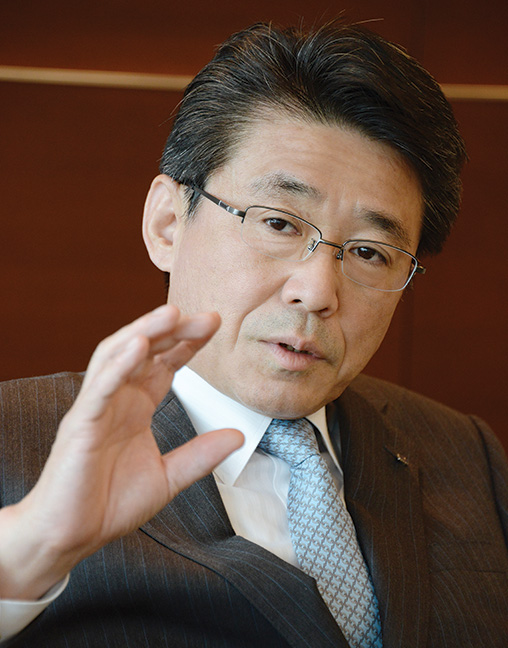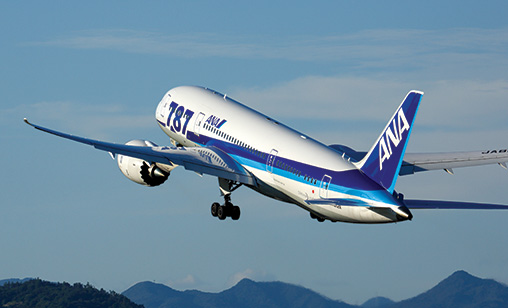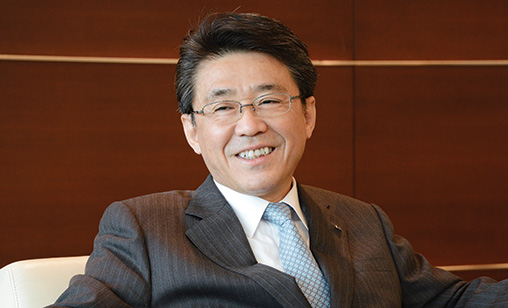Cover Story
WINNING OVER THE COSMOPOLITAN YOUNG
ANA Holdings boss, Shinya Katanozaka, a key architect of the two-year-old Japanese airline group, knows the company must break free from its domestic dependence to achieve its ambitious growth targets.
June 1st 2015
Shinya Katanozaka relishes a challenge. And that is just as well because he has plenty ahead of him in his new role as CEO and president of ANA Holdings Ltd. Read More »
Top of his list, he said when spoke to Orient Aviation last month, is to persuade big numbers of younger, affluent and more internationally sophisticated Japanese to replace its loyal but ageing domestic passenger base.
 |
“Japan’s demographic changes compel us to radically shift the company’s direction from the domestic to the international market. ANA has traditionally been heavily dependent on the domestic market,” said Katanozaka. “This dependence must change, especially as the company faces intensifying competition from both foreign carriers and a rehabilitated local rival, Japan Airlines (JAL).”
Katanozaka, a former senior executive vice president and director of ANA Holdings, whose expertise includes marketing and corporate planning, took charge of the airline group, with its 64 subsidiaries, on April 1. He is responsible for the bottom line, the mid to long-term strategy and strategic investment, including the group’s fleet. He is supported by All Nippon Airways (ANA) CEO, Osamu Shinobe, who runs day-to-day operations at the airline, the group’s key subsidiary.
In the decade to 2025, ANA Holdings plans to increase sales revenue from 1.7 trillion yen (US$14.24 billion) to 2.5 trillion yen and to achieve a 200 billion yen operating income target. That target is almost double the results planned for this fiscal year.
In ball park figures, ANA’s domestic passenger revenue for the 2015 fiscal year will be about 700 billion yen and international passenger revenue around 500 billion yen.
“In 2025, we are planning for the majority of our growth to come from our international business. Again, in ball-park figures this means domestic revenue will drop to around 600 billion yen, while international passenger revenue will be up to 800 billion yen. So we need to maintain our domestic market share while increasing international business,” said Katanozaka.
Achieving these international growth targets will come from expansion of the route network with ANA hoping to win international business from increasing inbound traffic, especially from events such as the International Rugby Championships and the 2020 Olympics and Paralympics Games. More international slots at Narita and Haneda airports, as yet unallocated, also may contribute to international passenger growth.
In the short to medium term, Katanozaka wants to expand the network as quickly as possible, to take advantage of the limitations on JAL. A condition of JAL’s rehabilitation is that the carrier cannot commit to new investments or open routes until 2017. JAL and ANA compete on many international routes.
“We want to change that by serving destinations where neither carrier has service,” he said. New international routes this year include Tokyo-Houston from this month with Tokyo-Kuala Lumpur to be launched in September.
“For the time being, or at least until the mid-term, we’ll be extending flights or opening flights to destinations that we have been considering and or were committed to be launched by my predecessors including Istanbul, Mexico and Sydney. These routes will be the first new routes that we’re going to add to our network.
But Katanozaka has his sights set further into the future by broadening the airline’s service network. By 2025, he is considering servicing cities in Latin America, Africa and Eastern Europe where no Japanese airline has flown.
 |
“Probably by 2025, the world business environment will be very different from now,” said Katanozaka, although he acknowledged Asia will remain at the core of ANA business.
“The potential demand for such destinations from Japan could be very limited, but actually we need to study about that. I would like to encourage the younger people in our company to think about the growth of the business, analyze our needs and identify routes ANA should serve.
In the current long term plan to 2025, Katanozaka has drawn a world atlas, showing the regions where Japanese carriers have not yet set wing. “This is to help stimulate our younger people,” he said.
In addition to the core group company, Katanozaka is responsible for ANAH’s budget airlines, Peach Aviation, based in Kansai, and Narita-headquartered Vanilla Air.
“Peach, in which we have a 38% stake, has performed much better than expected and is generating profits. It could be out of deficit at the end of this fiscal year,” he said.
“Vanilla Air, which is a wholly-owned ANAH subsidiary, is running a deficit. The company started life as a partnership between us and Tony Fernandes’ AirAsia. However, we went through a ‘divorce’. Whether or not we can generate profits for this year (ending March 2016) is critical.”
Vanilla’s performance in the full 2014 year was better than anticipated. Katanozaka said the budget carrier’s original projected passenger numbers were 1.1 million, but the latest traffic data indicated they would reach 1.14 million for the 12 months.
“Sales revenue should be 12.2 billion yen. We will still face an operating loss, but it will be smaller than predicted. Operating losses declined from 5.9 billion yen in 2013 to 3.6 billion yen last year,” Katanozaka said.
“Vanilla’s load factor in the closing months of the fiscal 2014 year showed steady improvement at 85% in January 2015 and 90% in February.”
Other positive factors that should help Vanilla Air are the installation of a new revenue management system managed by an expanded revenue management team and the April opening of a dedicated low-cost carrier terminal at Narita.
Ten years from now Katanozaka wants the two budget subsidiaries to operate to regional resort markets, predominantly in Asia.
 |
| 'We believe Asian aviation will be deregulated. We would like to be ready for that eventuality. But many Asian airlines are national flag carriers so we are limited in what we can do. I don’t think we will invest on a massive scale ' |
| Shinya Katanozaka CEO ANA Holdings |
“Both LCCs fly A320s, which can fly around 2,000 km. To service medium range routes up to 4,000 km, we may have to think about a shift in aircraft type. If you look at the globe to the east of Japan you see only Hawaii as a resort destination, so we need to go in the other direction, to Southeast Asia and China for resort destinations that can be flown by LCCs,” he said.
“The competition in this market is very fierce. In Asia, among others, we have Scoot, Nok, Tiger and Jetstar Thailand. There are many LCCs competing with each other.
“However, in Japan I have confidence we can succeed in this business by using our brand power. We want to capture a bigger share of the inbound travel market.”
ANA has developed ties with three domestic carriers, Air Do (13.6%), Solarseed (8.56%) and Star Flyer (17.96%) that include code sharing as well as held equity. When domestic carrier, Skymark, sought bankruptcy protection earlier this year, ANA offered to buy up to 19.9% of the carrier.
Details of the fate of stricken Skymark will be announced at press time, when Skymark must submit its rehabilitation plan to the Tokyo District Court. Katanozaka declined to speculate on the outcome.
He also oversees a wide range of associated ANA Group businesses. In the fiscal 2005 year, non-air income was 17% of operating revenue, or 232.9 billion yen, including its hotel business, which was sold in 2007.
In the current year, non-air income will be 11% of operating revenue, or l95.8 billion yen. By 2025, non-air business revenue is planned at 15% of total sales or about 375 billion yen, almost double the target for the current year.
That’s a formidable sum, but the group CEO is keen to develop non-air business where it can enhance group financial performance, particularly as the scope is diverse. A recent example of the strategy is the group’s 2012 purchase in Miami of the Panam Flight Training company and the launch of a training academy in Thailand in September 2014.
A little known fact about the ANA Group is that subsidiary, ANA Trading, is a major player in the Japanese banana business. It imports bananas from Ecuador and wholesales the fruit to supermarkets nation-wide, said Katanozaka.
Japanese foodstuffs such as high quality beef and fruit are becoming very popular in overseas markets, particularly in Asia. Katanozaka wants to leverage the ANA cargo hub in Naha, Okinawa, by exporting high-class Japanese food products to Hong Kong and Singapore, where affluent consumers have created demand for the quality produce.
| ANA Group builds Okinawa MRO facility ANA Holdings is coordinating with Mitsubishi Heavy Industries and other investors to establish an MRO facility that will target narrow-body aircraft such as the A320 family and the B737 in Okinawa’s Naha. The yet-to-fly Mitsubishi Regional Jet could be handled at the facility. Scheduled to open in 2016, the initial customers are expected to be predominately Japanese carriers, but it is planned to sell the service to non-Japanese carriers. “This is an opportunity for the ANA Group to contribute to the Okinawa economy by operating a high quality MRO service in the city. It’s a good investment for all involved. A win-win situation where there is great potential for growth,” said Katanozaka. |
ANA operates cargo flights between its Naha, Okinawa hub and four key airports in Japan: Narita, Kansai, Chubu and Haneda. It also flies to nine cities in Asia out of Naha and is planning routes to Amoy and Manila from October.
In August 2013, ANA Holdings announced a major investment of US$25 million in Myanmar’s Asian Wings Airways, the first investment in a Myanmar-based carrier by a foreign airline, ANA said at the time. A year later it cancelled the planned partnership. It said changes in the competitive environment in Myanmar and an inability to reach agreement on the proposed capital participation were the reasons behind the decision.
Despite this setback, Katanozaka is seeking opportunities to invest in Asian airlines to expand ANA’s network. The group is ‘studying various projects’ involving cooperation with Asian airlines “whether we take a stake or not”. For example, ANA has made code share deals with Philippine Airlines and Garuda, without any financial investment.
“We believe Asian aviation will be deregulated. We would like to be ready for that eventuality. But many Asian airlines are national flag carriers so we are limited in what we can do. I don’t think we will invest on a massive scale,” he said, although ANA Holdings has ample funds available if opportunities emerge.
By 2020, the group expects to be operating 265 airplanes at ANA and 40 aircraft at its budget carriers. At present ANA has a fleet of 250; 230 ANA aircraft and 20 among their LCCs. New types joining the fleet include the MRJ and the A320/321neo.
Developing ANA as a global brand is another priority for Katanozaka, especially as he was responsible for the airline’s award winning 2009 “Inspiration of Japan” product and services rebranding.
| A cultivated man Shinya Katanozaka, 59, was born in Kagoshima, Kyushu, the most southerly of the four main islands of Japan. A graduate in law from Tokyo University, he joined ANA in 1979 and has remained with the carrier for the 36 years of his working life. One of the key architects of two-year-old ANA Holdings, Katanozaka was a senior vice president and a board member of the group when Shinichiro Ito nominated him as his successor. Ito, who is now chairman of ANA Holdings, said Katanozaka “was passionate about his work and could see things from a wider perspsective”. He is a specialist in marketing, personnel and corporate planning and has had years of experience in product and services strategy and customer relations at the airline. Married, with two daughters, Katanozaka has broad tastes in music with a special fondness for Mozart. He enjoys traditional Japanese story-telling, but his greatest love is gardening. At weekends at his home in Tokyo’s western suburbs he tends what he calls his ‘tiny’ garden. He has two Japanese tangerine trees which bear about 100 of the sweet fruit every year. “To get a good harvest, you need to prepare the ground and trim off excess buds – to concentrate the plant’s energy,” he says. Business commitments make it hard to find the time to care for the garden as much as he would like, but he tries to maintain some colorful flower beds. Gardening, Katanozaka told Orient Aviation, reminded him of the human condition. He quotes an ancient Chinese poem, “every year the flowers bloom the same as usual, it is the people who admire the blooms that change”. |
The ANA brand is not as well known as its competitor JAL, said Katanozaka, mentioning ruefully that when he makes an internet search for ANA in the U.S. up pops “ANA – The American Nurses Association”.
“We have a board of advisors and they’ve been saying to us that we should change the name of ANA – maybe we should rename the airline ANA – Japan,” he said. “I’m still considering such advice,” he said.
“We are raising our brand awareness. In April, we sponsored a U.S. Ladies Professional Golf Association tournament at Mission Hills Golf Club in California and supported it with advertising on CNN. This was a very successful, profile raising event. ANA is now the Official Airline of the LPGA and the tournament. The newly-named ANA INSPIRATION drew a good response.
“A few weeks ago, we unveiled a B787-9 Dreamliner with a fuselage design based on the Star Wars character R2-D2. This received massive coverage world-wide and the aircraft will carry the design for five years from this autumn.
“Until recently, foreign passengers accounted for about 30% of the total passengers on our international flights, but it has gone up to almost 40%. “Coming back from Los Angeles recently I noted that about 60% of the passengers were non-Japanese and they were all enjoying our Japanese food.
“We want foreign passengers to enjoy flying with us. We want them to share their experiences on social networks with their families and friends, enjoying ‘The ANA Experience’ as a global brand.”
| Outside the airline box ANA Holdings is developing plans to operate food courts dedicated to Japanese cuisine - “Washoku” - throughout Southeast Asia. In June, the company will open a 1,300 sq. meter 600-seat Japanese food court with a sushi shop, tempura restaurant and a Japanese pub, or izakaya, in Singapore. It will be operated by Global Retail Partners, a joint venture with food and beverage companies and other investors. ANA Trading, with 40% of the enterprise, is the biggest investor. A similar food court is planned for Singapore’s Changi Airport and at other locations throughout Southeast Asia. |